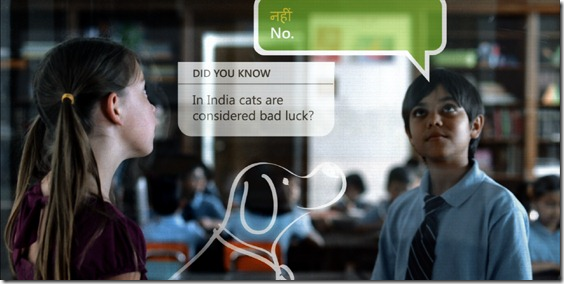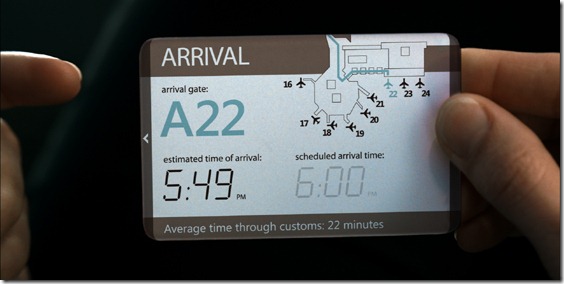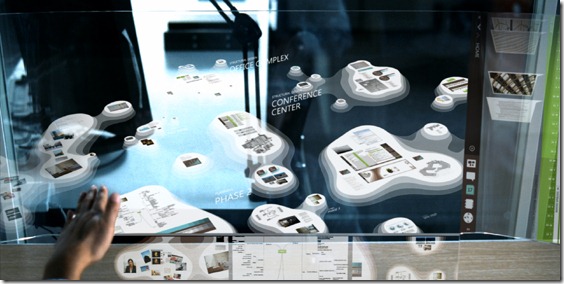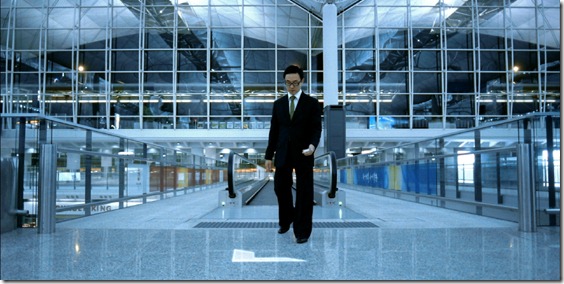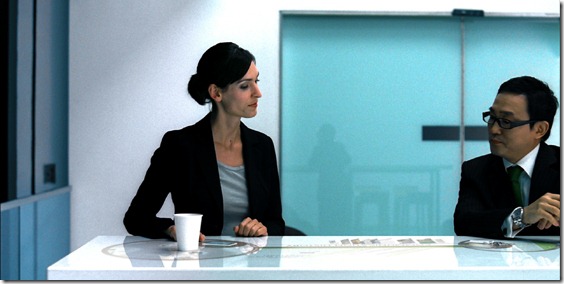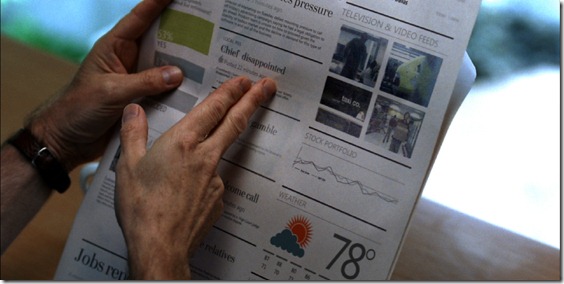Back in 2009 our Office team released the Productivity Vision video you see above. It’s sometimes referred to as the “Office 2019” video as it was a view 10 years ahead, so I thought it may be interesting to look back at that video and explore if any of the predictions it made have come to pass – or if it was just a fictional view in to a utopian future. Let’s take a look at a few of the scenes from the video.
Scene 1: The simplicity of the first scene hides a broad array of technologies at play, and while this exact scenario of two kids talking from opposite sides of the world hasn’t been fully realized, lots of the pieces of the puzzle are being worked on here at Microsoft. The scene shows smart interactive displays, flat optics, OLED’s, real-time language translation, cultural translation, auto stereoscopic 3D displays and gaze tracking.
Stevie Bathiche and his team are working on much of the technology to make this exact scene a reality – he calls it’s the magic window and it takes advantage of technologies like Kinect and The Wedge. So I think we can chalk this one up as work in progress and I’ll keep my eye on the work of Stevie and his team.
Scene 2: In this scene, we see a woman on a plane keep in touch with what’s going on with her kids at school. 2 years ago there were very few commercial aircraft with Internet connectivity so some progress has been made there (albeit domestically, not internationally). It shows technology we already have such as shared calendaring and role-based interaction, but the one feature that people often remark on is the digital boarding card that was inspired by a project called Lucid Touch from Microsoft Research – and there was talk of Sony doing something similar with a PSP. I think this highlights one of the benefits of videos like this – they project what the future may be like but the reality for this scenario is that we’re more likely (and already do) use our smartphone’s for this kind of task. Most smartphone’s now have apps that allow you present a digital boarding card and track flights and some companies like British Airways have taken that even further as you can see from this short video of their app on Windows Phone.
I’ll mark scene two down as some progress and some useful learnings.
Scene 3: In this scene, we see a guy in an office and some idea on what a next generation user interface may look like as well as the proliferation of displays, many of them transparent OLED, but also some examples of pico projection. Throughout this scene we also see rich visualizations being used to convey information. On the latter point, there has been a lot of progress across the industry and I even posted a blog entry last week about the emerging discipline of data scientists. Sites such as visual.ly and books Visual Complexity are testament to the progress in this area. The explosion of infographics on the Internet goes hand in hand with the explosion in data and for our part, tools like Worldwide Telescope are being used as rich visualization tools (I’ll have a new video on that soon) and projects like Project Crescent from our SQL Server team.
In terms of the UX exploration, that’s a work in progress and pico projectors are now widely available – and I’ll come back them a little later in this post. As for the 3D view the guy has on his desk, and the effortless way he moves a digital document from one screen to another, you need look no further than a few ongoing project in MSR to see how we continue to explore these area. Just last week, Holodesk took the 3D desk a step further and LightSpace shows how the digital transfer may be possible – KinectFusion shows the real-time 3D re-creation of a space. These are all prototypes of course but they do show that the video isn’t a work of science fiction – it’s based on areas we’re pursuing in our labs.
So for scene 3, I’d say work in progress – some relatively near to arriving, some still a little out there.
Scene 4: In this scene, we see a guy in a (remarkably empty) Hong Kong airport. He’s using his mobile device for wayfinding, language translation, projection and augmented reality. Also easily missed is we see him (and his female colleague) taking advantage of “preference based communication routing”.
There has been plenty of progress from this scene – of course smartphones are now regularly used for wayfinding and there are a good number of augmented reality apps out there, many on iPhone and Android and we’re starting to see them on Windows Phone too.
What about that preference-based communication routing thing? Look no further than Lync, which allows me to route my calls in all manner of ways – having my desk phone, PC and cell phone ring simultaneously, or a variation. We’ve also recently added conversation translation to Lync via a free add-on that takes advantage of our Bing translation service. Okay, this isn’t doing exactly what’s shown in the video but it’s the enabling technology.
The pico projection is an interesting one as technically this is doable right now – in fact LG showed this back in 2009 – but power consumption is the big challenge here. We want our phones to give us more than an hour or two of use and adding a projector in to a cell phone is in direct opposition to that. However, that’s not stopping our teams in Microsoft Research from exploring augmented projectors and multitouch applications on everyday surfaces.
So for scene 4, some clear progress, some learnings and some more work in progress.
Scene 5: This scene is similar to the first in that there is a lot going on from a technology standpoint. Public space technology, accessing of personal profiles and content using biometric authentication, shared workspaces and merged communications history, ad-hoc device partnerships, 3D visualizations and surface top multitouch computing.
It turns out that much of that technology has been with us for longer than the life of the video. Ad-hoc device partnerships have existed for some time, using technology like Bluetooth, we’ve seen thumbprint logon on laptops and mobile devices for many years and RFID tags are now being used in 10 million consumer travel cards in London alone. Merged communications doesn’t look this good but there are elements of this in email clients today – overlaying calendars and project workspaces. The 3D visualizations seen in the video use Photosynth which has been publicly available for a number of years and capable of amazing visualizations – it’s even appeared on CSI.
The surface top multitouch computing? I give you Microsoft Surface 2.0 so on this scene, I think we can say significant progress has been seen.
Scene 6: Ahhh, the digital newspaper scene. This is probably the most questioned part of the video in my experience of showing it – basically people want to know when they will have that paper. The most likely technology for this is some form of flexible e-paper. Back in Sept 2010 Sony demonstrated something akin to this and continues to work on it – and though many companies are working on a solution, it’s still not quite here.
One observation is how our attitudes have changed over the last 2 years towards e-reading. The original Amazon Kindle was released in November 2007 but it’s only over the last few years that e-reading has really taken off. The reason for this are many (technology, cost, power, availability of content) but it does help make the point that the technological changes we explore are subject to societal and economic changes which are often much more powerful and can limit the adoption rate significantly. I’m reminded of Microsoft researcher Bill Buxton and his thesis that most technology we see as “revolutionary” today has been hidden in plain sight for 20 years or more.
I think the team behind the video did a pretty good job at predicting the future – and I didn’t even mention their predictions on the wide use of slate devices, touch and gesture interaction. And they still have 8 years to run against their timeline of ten years.
And having mentioned Bill Buxton, I’ll leave you with a quote from him – “Anything that’s going to have an impact over the next decade—that’s going to be a billion-dollar industry—has always already been around for 10 years”. So you could say that creating videos like these is as much an exercise in looking backwards as it is in looking forwards!


